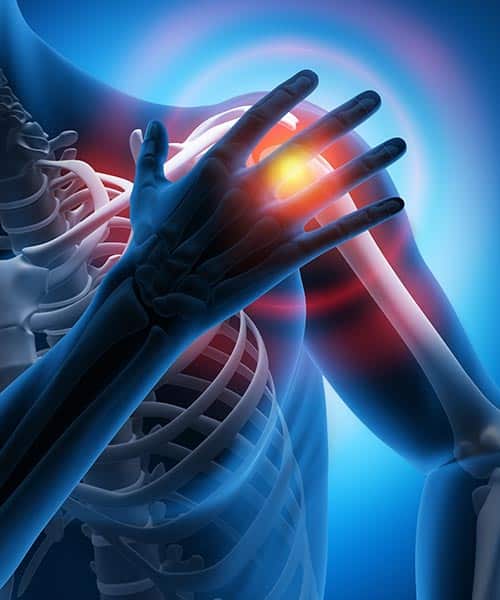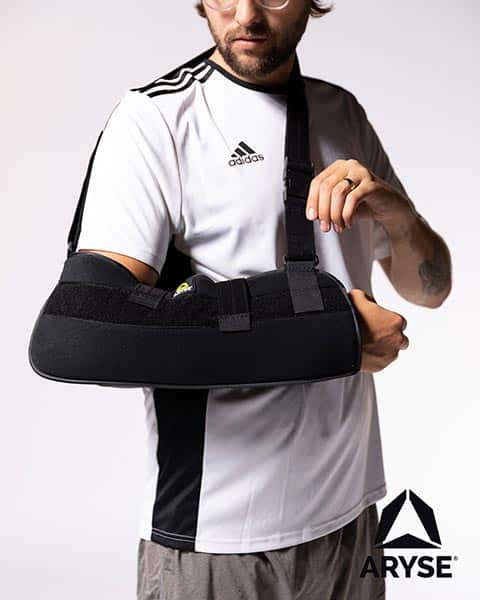Shoulder Support Made Easy: Artik Med's Shoulder Brace
SHOULDER BRACES
Shoulder injuries usually tend to be the type of injury that requires your shoulder and arm to be fully immobilized. Shoulder pain is common in older adults, therefore, wearing a shoulder brace can be greatly beneficial. The most common conditions include frozen shoulder, rotator cuff tears, and rotator cuff tendinopathy.
Orthopedic shoulder braces can be used in the early stages of injury for support and protection to help the healing process, and also to assist the rehabilitation process. A shoulder orthosis will limit the shoulder’s range of motion and strengthen the shoulder muscles, so finding the right product is essential.
- Arthritis
- Tendinitis
- Dislocation
- Bone spurs
- Cartilage tears
- Rheumatoid arthritis
- Osteoarthritis
- Bankart repairs
- Bursitis
- Brachial plexus injury
- Torn cartilage
- Capsular shifts
- Glenohumeral dislocations
- Rotator cuff capsule sprains or tears
- Shoulder instabilities
- Sprains
- Post-surgery recovery and more.
We carry Medicare-approved shoulder braces, so reach out to your doctor if:
- You feel pain when raising your arm.
- You can’t use your shoulder.
- Your arm feels weak or numb.
Our shoulder braces are approved by Medicare. Our bilateral options offer adjustable support for maximum comfort while keeping your shoulder in place. If you’re not sure which medical shoulder brace is right for you or if you’re eligible for insurance coverage, Artik Medical Supply will provide the guidance you need. We can even communicate with your doctor to determine the best shoulder support for you.
Contact us today to check for insurance shoulder brace coverage.
PDAC
Shoulder 1 – Click Here / Shoulder 2 – Click Here

Any Questions? Contact Us Here!
Or Call Us Today at (888) 433-9796
ARYSE METFORCE SHOULDER BRACE
The ARYSE METFORCE SHOULDER immobilizes the arm to reduce strain on the shoulder and provide support for injury recovery.
Adhesive capsulitis, arthritis, Bankart repairs, bursitis, capsular shifts, glenohumeral dislocations and subluxations, mononeuritis multiplex, post-surgery recovery, rotator cuff capsule sprains, rotator cuff tears, shoulder instabilities, shoulder sprains, tendinitis, among others
Bilateral and universal, lightweight, breathable, and comfortable
Polyurethane foam, polyester, nylon, polyformaldehyde
- Detach pillow from sling to access wrist strap, then reattach sling to pillow
- Slip shoulder strap over neck
- Unclip waist strap from brace and wrap around midsection
- Slide hand of involved shoulder through sling, ensuring involved shoulder is in neutral position
- Secure hook-and-loop straps and tighten to desired comfort level
Additional comfort can be achieved by attaching foam ball to sling where involved hand rests.


ARYSE TRU-RANGE SHOULDER BRACE
The ARYSE TRU-RANGE SHOULDER is an adjustable brace that provides support for injury recovery.
Adhesive capsulitis, arthritis, Bankart repairs, bursitis, capsular shifts, glenohumeral dislocations and subluxations, mononeuritis multiplex, post-surgery recovery, rotator cuff capsule sprains, rotator cuff tears, shoulder instabilities, shoulder sprains, tendinitis, among others
Adjustable angle positioning, bilateral, lightweight, breathable, and comfortable
Polyurethane foam, metal, polyester, nylon, polyformaldehyde
- To assemble shoulder brace, attach forearm and bicep hook-and-loop straps to arm plate
- Slip shoulder strap over neck and slide hand of involved shoulder through bicep and wrist straps
- Tighten forearm and bicep straps to desired comfort level
- Tighten waist strap to desired comfort level
- Adjust foam wedges to achieve desired angle. 30°, 60°, and 90° angles can be achieved by using large foam wedge only. For maximum abduction of 120°, combine small and large foam wedges
Frequently Asked Questions About Shoulder Braces
Orthopedic shoulder braces can be worn immediately following an accident to provide support and protection, speed healing, and ease the recovery process. The range of motion of the shoulder can be restricted, and the shoulder muscles can be strengthened with the help of an orthosis.
Shoulder braces can help with a variety of conditions, including arthritis, tendinitis, dislocation, bone spurs, cartilage tears, rheumatoid arthritis, osteoarthritis, Bankart repairs, bursitis, brachial plexus injury, and torn cartilage.
Finding the right shoulder brace is essential because it will limit the shoulder’s range of motion and strengthen the shoulder muscles, which can help with the healing and rehabilitation process.
Yes, shoulder braces sold by Artik Medical Supply are approved by Medicare.
The single-sided design of the Seamless Motion shoulder brace allows it to conform closely to the shoulder joint while still providing ample anterior and multidirectional support.
Wearing a shoulder brace can improve proprioception by increasing compression on the receptors in the skin, which can improve muscle control and coordination.
Shoulder braces that provide compression are ideal for athletes with mild injuries who need support and protection while continuing to perform. Muscle strains and shoulder AC separations are the optimal conditions for these kinds of braces.
Putting on a shoulder brace is the initial step in using one. The central bar must be at a right angle to your upper arm and elbow. Wrap the strap across your shoulders and fasten it with the buckle. The padded sleeve’s intended location is under the underside of the opposing arm or axilla. The straps might also need to be readjusted for a better fit.
Cushions for your bed and seat, compression clothes, extra braces and sleeves, and extra shoulder brace components, in case some of them fray or come free, are additional accessories for shoulder braces.
You can speed up your recovery with a shoulder brace by combining shoulder brace usage with resting the area or engaging in exercises recommended by your doctor or physiotherapist.
